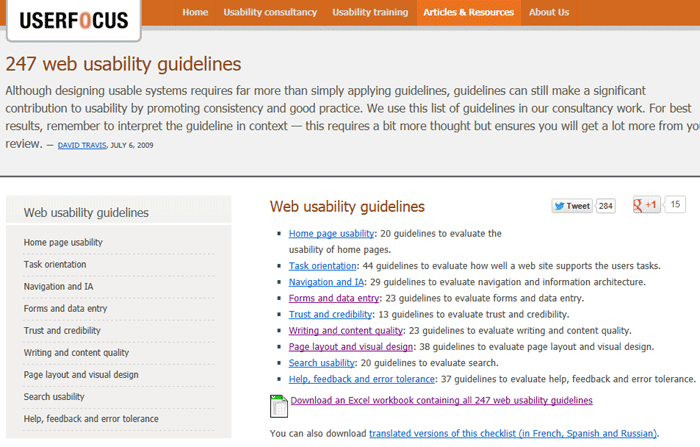(Post 2 of a series on quick research and usability techniques. Start-up’s can use these techniques fairly easily to connect to and understand their end users better, as well as maintain usability standards on their products.)
In my last post, I introduced a discount usability engineering method called the ‘Expert Usability Review’ – A method best suited to start-up’s who have access to skilled and experienced usability / design professionals who can conduct a Usability Review.
Post 2 introduces a related technique called the ‘Heuristic Evaluation’.
Start up’s that don’t have a usability / design team in place, can start focusing on usability and ease of use, using the ‘Heuristic Evaluation’ method – A method with similar goals to the Expert Usability Review, but a relatively easier starting point for novice researchers.
In a Heuristic Evaluation (or Heuristic Review), the reviewers identify issues by looking at an interface in context to a pre-decided set of heuristics. Violations to any of the heuristics indicate non-compliance / potential usability issues.
‘Heuristics’ are rules of thumb – Broader than design guidelines, typically available as self-sufficient ‘sets’ (e.g. Nielsen’s 10 Usability Heuristics / Gerhardt-Powals’ cognitive engineering principles) that can be used standalone / along with other sets.
Popular examples:
Visibility of system status: The system should always keep users informed about what is going on, through appropriate feedback within reasonable time. (Jakob Nielsen)
Reduce uncertainty: Display data in a manner that is clear and obvious. (Gerhardt-Powals)
The set of heuristics used act as a guideline – making this method more of a check list based audit rather than requiring reviewers to intuitively identify issues by drawing upon a deep knowledge of usability and UI in general.
(More about the technique and how to conduct Heuristic Evaluations at Usability.gov, Smashing Magazine and the NN Group)
One of the drawbacks of the Heuristic Evaluation method, is that the issues identified are dependent on the list of heuristics used. So if the set of heuristics is too narrow, there is a chance of some issues going unidentified. On the other hand, if the list of heuristics is very large, the review would take a very long time to do.
The most popular set of Heuristics are Jakob Nielson’s 10 Heuristics. However, these are broad guidelines – and may be too abstract for a lay person to interpret and apply.
 The 275 Web Usability Guidelines from User Focus are more literal and therefore much easier to understand for the lay person. Moreover, these guidelines are available in a neat Excel spread sheet format that includes instructions on how to use them and an auto-calculated numeric rating for guidelines compliance.
The 275 Web Usability Guidelines from User Focus are more literal and therefore much easier to understand for the lay person. Moreover, these guidelines are available in a neat Excel spread sheet format that includes instructions on how to use them and an auto-calculated numeric rating for guidelines compliance.

To end, here are a few tips you can keep in mind while attempting to do a Heuristic Evaluation:
Start with a Knowledge Transfer
Before critiquing a product, it is important to understand its context and usage.
The knowledge transfer must enable a good understanding of the product strategy and goals, target audience, known trouble points, constraints and design centres. The KT must include a walkthrough of all features, screens and task flows that are critical to the product.Define the scope of the review
While this is not necessary for a simple product or a product with a manageable number of screens, in a complex or large product, defining the key task flows and screens to be reviewed is important to keep the review manageable.
With some exceptions, the 80 /20 rule is a good way to do this – Attempt to review 20% of the product features that are used 80% of the time.Select the set of heuristics that are right for your product
There are plenty of heuristics available online.
Keeping n mind the product you plan to review, it is important to decide whether to use a generic set of heuristics (Like Jacob Nielson’s 10 Heuristics / User Focus guidelines) or whether domain specific / niche heuristics would be more effective. In niche or highly targeted products (products for senior citizens, children, disabled users, mobile phone hardware etc.) generic heuristics may be ineffective for unearthing all issues.Select a set of heuristics that are right for the reviewer
The reviewers who are going to be using the heuristics, need to be comfortable / familiar with the heuristics in order to interpret and apply them effectively.Focus on issue identification vs. recommendation
A common tendency among newbie reviewers is to jump right into fixing the problem / wording the issue as a recommendation. It is important to keep the Heuristic Review focused on issue identification, in context to a given set of heuristics. In fact, an issue may / may not be accompanied by a corresponding recommendation – Issues are sometimes too complex to be tackled by a quick written recommendation and need a larger, more focused redesign effort.Rate issues to help prioritize
Doing this helps focus the post review effort of addressing the issues identified through Heuristic Review.
Are you a design thinker evangelizing or facilitating user research and usability methods within your start-up?
We would love to hear about your experience / answer any questions that you have about the methods that you used.
Post 3 coming up soon, will showcase a Guerrilla Research technique – Remote Usability Testing. Look out for this post to learn more about the method and to compare the issues found through Usability Testing, against issues identified through the Expert Usability Review.
We invite members of the start-up community to volunteer their screens / functions for use as examples in upcoming posts showcasing additional research techniques. Email me at devika(at)anagramresearch.com to check whether your screen is eligible for selection.


